When someone is thinking of starting their bonsai, the first thing that usually pops in their mind is, which is the best bonsai tree for beginners? If you are interested in bonsai and want to know which trees are good for getting started, then you’re in luck! Because that is exactly what this article’s about.
Any tree that is native to your area should be easy for you to maintain as a beginner. Other than that, some species of trees are inherently more low-maintenance, like Junipers, Figs, and Maples.
A lot depends on getting the right size of the tree and the environment you want to place it in. You have to also factor in the amount of time you want to spend on it before deciding on which tree to get.
I’ll try to go over which species are inherently beginner-friendly, and what you should choose based on your needs. Let’s get to it then, shall we?

What Are The Most Beginner-Friendly Bonsai Trees?
I’ll start with the core element of deciding the difficulty level of bonsai trees, their species. Some trees are naturally easier to maintain, and some trees are naturally demanding and require constant care to grow properly.
As a beginner, you would want to stay away from the inherently high maintenance trees like the plague. I remember when I first started my venture down this road, I got myself a Snow Rose. It was a beautiful tree, but it ended up dying because I couldn’t care for it properly.
With that in mind, I’d like to list some trees that are extremely simple to maintain. As a beginner, these are the type of trees you would want to get,
Boxwood
Common boxwood or Buxus Sempervirens is one of the easiest trees out there for bonsai. These trees are as hardy as you can ever get. They also have a rapid growth rate, so they can recover from over-pruning.
A lot of newbies tend to over-prune their trees, and boxwoods are resilient enough to recover from it much better than other bonsai trees.
It has a shallow root system, so repotting it is relatively hassle-free. It cannot tolerate below-freezing temperatures, but it also doesn’t need to be out in the sun too long. A moderately shaded spot with occasional sunlight is perfectly ok for a boxwood.
These requirements are much easier to fulfill than some of the other bonsai trees. It is worth noting that Japanese variants of boxwoods are more resilient than the common boxwood you find in Europe or America.
Japanese Maple
Japanese maple is another viable option for beginners. These trees are very pleasing to look at, and they require relatively little care for how good they look.
They only need to be watered daily during the growing seasons and hot summers. Overwatering isn’t usually a problem with it. Fertilizing Japanese maple is relatively simple, as it only needs to be fertilized once a week.
You can prune it all year round, which is especially helpful for beginners who don’t have in-depth knowledge about pruning times.
Japanese maple is resilient, so it usually does not contract many diseases. The only nuisance it faces is from sap-suckers known as aphides. They usually only attack during spring, so with a little care, you can prevent it quite easily.
Japanese maple only needs to be repotted around every two years or so. That makes it very easy for beginners to handle.
Juniper
Junipers are amazing trees for outdoor bonsai. There are close to a hundred different species of Junipers that people use for bonsai. They are beautiful trees, and they are highly resilient.
Junipers like to be potted outside, but if you want, you can place them indoors too. Just make sure that they have access to enough sunlight.
These trees can withstand almost all-weather conditions, so you only need to provide nutrients and groom the way you want it to look, no need to worry about anything else.
Cotoneaster
Cotoneasters are viable for beginners because they are not very picky about how you take care of them.
A lot of bonsai trees need specific pH levels in their water or a certain degree of purity. Cotoneasters can do just fine with regular water, but they do need a lot of it during summer. Giving them too much water in winter may cause root rot, so only water it when necessary.
It is best to prune them in spring, but they can handle constant pruning much better than most other bonsai.
Figs
Figs are probably the best trees for indoor bonsai. They are hardy and rarely get any pests or infestations. Figs can do well with little sunlight, but it makes them grow slower compared to one that gets a relatively decent amount of sun.
Figs also have a high tolerance for humidity. They thrive in humid environments where other trees may die out. You only need to water it when needed as figs don’t care about a routine. As long as the soil isn’t entirely dehydrated, they will do just fine.
Aside from these, any tree that grows naturally in your geographic location is perfect for bonsai. Those trees are more suited to your climate than others.
Even so, do a bit of research to see if you can handle the amount of maintenance one of those trees might need before you go ahead and buy them.
How to Choose the Right Bonsai Tree?
When trying to choose what sort of bonsai would be best for you, you need to think about four main things.
Firstly, how big do you want it to be? Bonsai plants can come in various shapes and sizes. After selecting a tree, do a bit of research on how big they grow or how to contain them.
Secondly, consider your climate. Even though something like a fig is considerably durable and beginner-friendly, if you live in a wintery region, it will not be able to thrive.
Even beginner-friendly plants have different levels of skill requirements. Some plants can live longer, and some plants can survive in adverse conditions better.
But they might need different levels of skilled maintenance. It’s a good idea to make sure you have the necessary tools. And that you know how to use them
Finally, you need to be careful while buying the plant itself. Check and make sure that all the branches are healthy and not crossing one another. See if the leaves are vibrant and colorful. Also, make sure that the roots are not sticking out too much.
Which Trees Should You Avoid as A Beginner to Bonsai?
Shimpaku, Fukien Tea, Tree of a Thousand Stars, or snow rose are some trees that need expert care. They are hard to shape with wires and require extensive care throughout the growth periods.
If you are a beginner, then stay away from these before you learn to handle some of the easier trees first. You will eventually reach a point when no tree would be hard for you to bonsai. But until you get to that point, it is a good idea to take it slow. Bonsai rewards patience more than anything.
I usually tell novices to get a native tree instead of a fancier one that’s born in a different environment. That makes it easy for both the tree and the person taking care of it.
If you did enough research on a particular plant you like, then go right ahead. But consider how hard and time consuming bonsai is, playing it safe is the best thing to do.
Final Thoughts on Which is the Best Bonsai Tree for Beginners
Hopefully you have seen that there is a perfect beginner bonsai experience ready for you, all that you need to do is to take that first step and make the decision to start today.
If you are just learning about bonsai trees and looking to purchase high quality trees that will likely live longer than you then I would highly suggest checking out Bonsai Boy Trees as they are a long lasting New York business that provides trees for all price ranges!




